Miracles of expressive art therapy (eat) in dealing with autism spectrum disorder (asd)
By: Dr. Nayanika Singh
Expressive Art Therapy due to its multi-modal & integrative approach has been found to be aneffective intervention for dealing with Autism Spectrum Disorders.Keeping that in mind the present article attempts to provide its readers with a snapshot of the role and contribution of Expressive Art Therapy as a handy intervention tool used for the betterment of such children.
Autism is a developmental condition that affects social interaction and behavior in human beings. The condition falls under a wider group known autism spectrum disorder (ASD). The diagnostic criteria as per DSM-5 for ASD include impairment in social communication, and behaviours that are restrictive or repetitive in nature. They have a triad of impairments ranging from lack of/or very restrictive social communication, social interaction and social imagination, reading body faces and body language.
Expressive Art therapy is a multi-modal therapy that uses the creative process of art-making to improve and enhance the physical, mental, and emotional well-being of individuals of all ages. It is based on the belief that the creative process involved in artistic self-expression helps people to resolve conflicts and problems, develop interpersonal skills, manage behavior, reduce stress, increase self-esteem, and self-awareness, and achieve insight (American Art Therapy Association). EAT mainly uses basic art forms used as tools for intervention for both normal and clinical population are as follows:
- Visual Art- using drawing, painting, sculpture, scribbling, doodling, sand play etc.
- Dance/Movement therapy – based on body movement, rhythm, coordination & non-verbal communication.
- Music therapy –making use of various types of sounds & musical notes.
- Drama/Theatre- making use of role play, mimes etc.
- Creative Writing
- Storytelling-making use of stories based on real/imaginary, concrete/abstract characters
- Guided Imagery& Mindfulness
GOALS OF EAT:
The heart and soul of EAT is based on the following goals & objectives:
- Self -Expression.
- Active Participation.
- Imagination
- Mind-Body Connection.
The art therapist focuses on creative expression to develop the child’s imagination, communication and socialization skills allowing them to gain insight and understand their feelings, at their own pace using simple art material such as:
- Markers, pencils and pastels
- Feathers, chenille stems, pom-poms
- Play dough and clay
- String, felt and other craft materials
- Sand
- Shaving cream finger-painting
Research conducted across the globe has indicated that using various art forms as a medium for expression for autistic children has myriad benefits ranging from;enhancing their ability to: imagine & think symbolically to recognizing and responding to facial expressions and body language, managing bodily sensations to improvement in their fine motor skills. Furthermore EAT has been particularly beneficial in dealing with children suffering from Autism Spectrum Disorder by providing them a calming, therapeutic and non-threatening environment to be able to assist them in exploring, understanding and communicating their feelings, emotions, needs and wants through various art forms such as: visual arts, dance/movement therapy, music/sound therapy, drama/theatre, guided imagery and mindfulness techniques. These art forms have also been found to be beneficial in enhancing self-awareness, social skills, self-esteem and self- confidence thereby leading to better overall productivity and well-being.
The various art based interventions that can be used to deal with children suffering from ASD include techniques such as:
- Individual & group drawing
- Emotion Drawing
- Repetitive dance moves
- Inspirational card drawing
- Drawing an animal or bird
- Painting with music
- Figure painting
- Collage making
- Animal sculpture
- Making used of mixed medium including computer art & designing.
BENEFITS OF EAT FOR ASD:
Some areas where art therapy can be particularly useful for dealing with children with ASD include:
- Developing their communication skills & interactive expression.
- In Imagination and abstract thinking
- In building social communication & relationships
- For integration of various sense modalities
- To enhance developmental maturation& visual-spatial abilities
- For enhancing their recreational and leisure based skills
- Gross and finer motor skills& dexterity.
In the end, I would like to end with a quotation by Elizabeth Broun, “Art is not always about pretty things. It is about who we are, what happened to us, and how our lives are affected”.


Best
My relatives always say that I am killing my time here at net, however I know I
am getting know-how everyday by reading thes pleasant articles or reviews.
This is a topic that’s close to my heart… Thank you!
Exactly where are your contact details though?
Hello
THanks for liking our blog. You can contact on iahrw2019@gmail.com